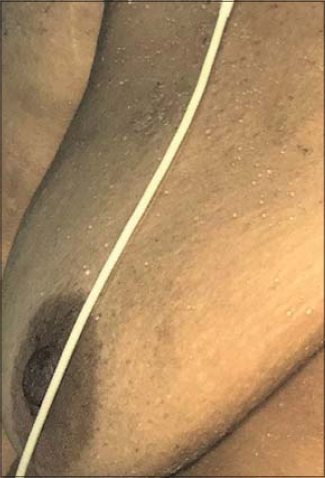|
|
Widespread miliaria crystallina in intensive care unit
Samia Mrabat , Hanane Baybay, Laamari Kaoutar, Sara Elloudi, Zakia Douhi, Fatima Zahra Mernissi
, Hanane Baybay, Laamari Kaoutar, Sara Elloudi, Zakia Douhi, Fatima Zahra Mernissi
Department of Dermatology, University Hospital Hassan II, Fes, Morocco
Corresponding author: Dr. Samia Mrabat
Submission: 09.03.2020; Acceptance: 09.05.2020
DOI:10.7241/ourd.2020e.100
Cite this article: Mrabat S, Baybay H, Kaoutar L, Elloudi S, Douhi Z, Mernissi FZ. Widespread miliaria crystallina in intensive care unit. Our Dermatol Online. 2020;11(e):e100.1-e100.2.
Citation tools:
Copyright information
© Our Dermatology Online 2020. No commercial re-use. See rights and permissions. Published by Our Dermatology Online.
A 56 years old, with a history of type 2 diabetes, was admitted in the intensive care unit for the management of stage E pancreatitis. She was febrile, unconscious, ventilated and had a gastric feeding tube. She was put on broad spectrum antibiotic therapy for extensive extrapancreatic fluid collectioSns. As her fever began to break, her skin erupted with widespread vesicles. We found clear, waterdrop-like vesicles, 1–3 mm in size, scattered across her chest and shoulders, crossing dermatomes and sparing mucosae. These findings were consistent with miliaria crystallina. Unfortunately, the patient died few days later from septic shock.

|
Figure 1: Widespread clear 1-3 mm vesicles on the shouders and the trunk. |

|
Figure 2: Drop-like vesicles sitting on healthy skin. |
Miliaria crystallina is a transient occlusive sweat gland disorder resulting in the leakage and retention of sweat into the epidermis [1]. Small 1- to 2-mm flaccid (MC) vesicles that rupture easily characterize MC. This skin condition resolves spontaneously and requires no treatment [2].
Consent
The examination of the patient was conducted according to the Declaration of Helsinki principles.
The authors certify that they have obtained all appropriate patient consent forms. In the form the patient(s) has/have given his/her/their consent for his/her/their images and other clinical information to be reported in the journal. The patients understand that their names and initials will not be published and due efforts will be made to conceal their identity, but anonymity cannot be guaranteed.
REFERENCES
1. Anbu AT, Williams S. Miliaria crystallina complicating staphylococcal scalded skin syndrome. Arch Dis Child. 2004;89:94.
2. Wat M, Nedorost S, Honda K. Clear vesicular eruption in the intensive care unit. JAAD Case Rep. 2019;5:754-6.
Notes
Source of Support: Nil,
Conflict of Interest: None declared.
Request permissions
If you wish to reuse any or all of this article please use the e-mail (brzezoo77@yahoo.com) to contact with publisher.
| Related Articles | Search Authors in |
|
 http://orcid.org/000-0003-3455-3810 http://orcid.org/000-0003-3455-3810
|



Comments are closed.